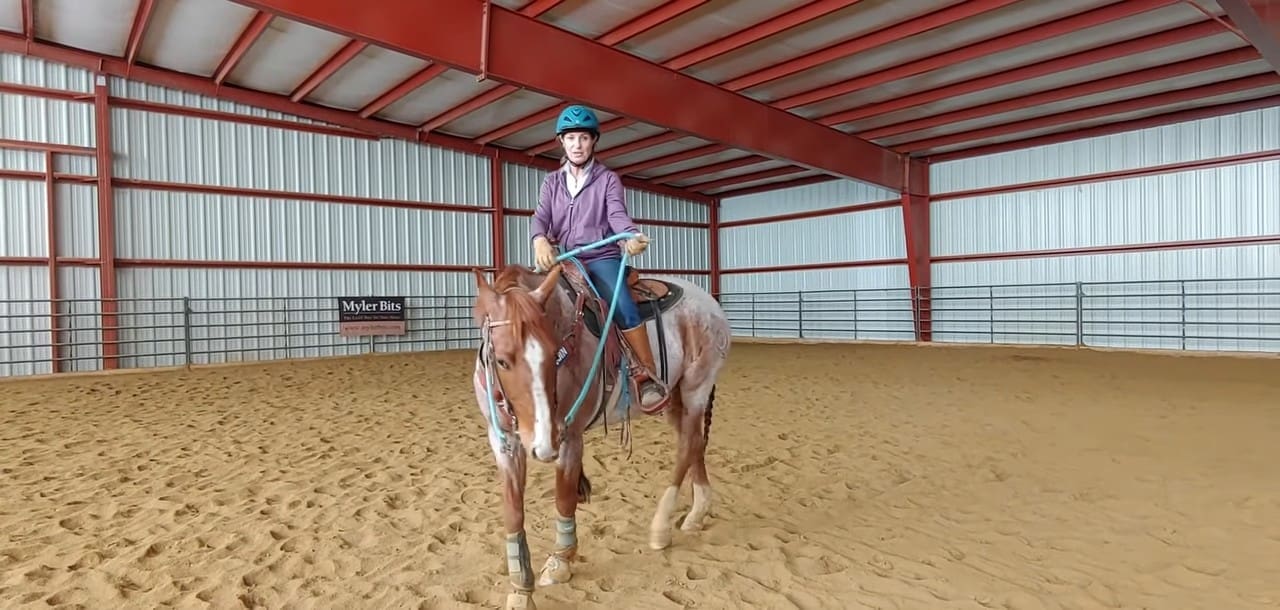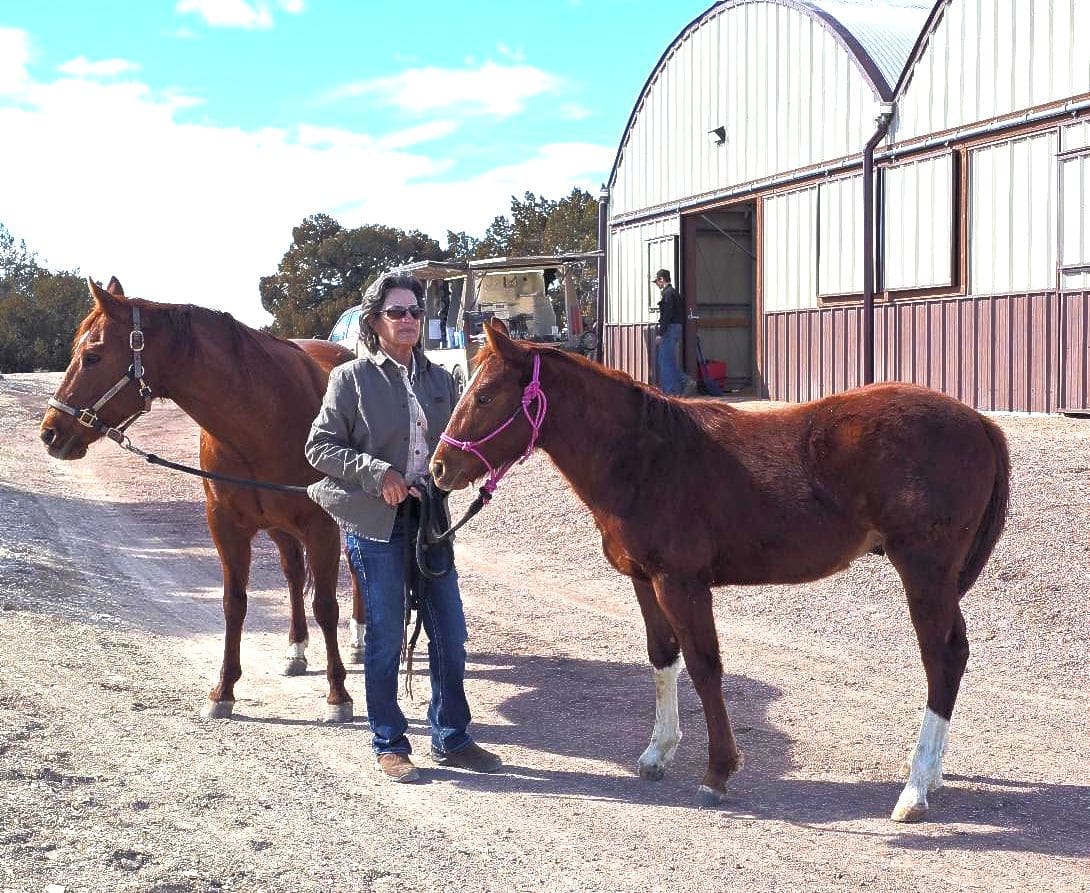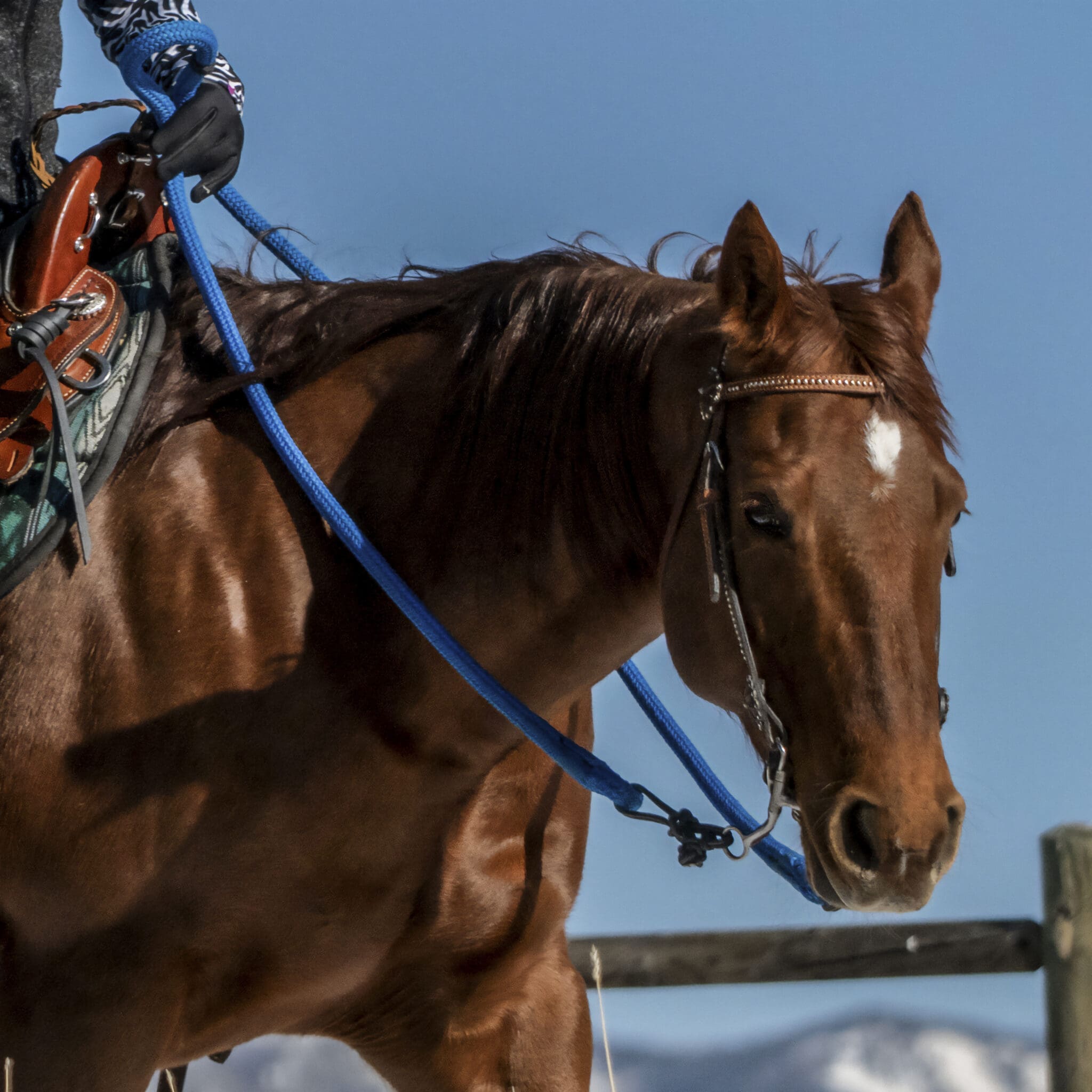
 Before the horsemanship clinic even started, I could see the bad dynamic between the horse and his owner. The big brown gelding was agitated and acting aggressively toward his owner, a middle-aged woman, who was clearly scared, angry and frustrated with the horse. As I started the first groundwork session of the clinic, I could see nothing but animosity and disdain from the horse.
Before the horsemanship clinic even started, I could see the bad dynamic between the horse and his owner. The big brown gelding was agitated and acting aggressively toward his owner, a middle-aged woman, who was clearly scared, angry and frustrated with the horse. As I started the first groundwork session of the clinic, I could see nothing but animosity and disdain from the horse.
This was a big, dominant horse, who was obviously disapproving of the woman’s attempts at leadership. He pinned his ears and gestured with his teeth in a threat to bite as she led him; swishing his tail, he leaned his hip toward the woman in a kick threat when she tried to move him out of her space; when she jerked the lead rope to make him stand still, he was prepared to strike at her. He was so agitated that standing still and relaxed seemed impossible. The more his owner tried to make him stand and obey her authority, the more agitated, aggressive and fidgety he became.
On the woman’s part, she was repeatedly jerking the lead, in a punishing manner, with no release of pressure and no clear rhyme or reason as to what behavior she was correcting. She was highly emotional with a confusing blend of anger, fear and frustration. As she became the center of attention for everyone watching the clinic, she became increasingly embarrassed at the behavior of her horse, which in turn led to more punishment bordering on retribution. To be fair, the horse was aggressive, so I could understand her emotionality, but I could not place the blame on the horse.
Things were going downhill at the moment I took the horse from her. I was prepared with a rope halter and a 15 training lead. I kept a safe distance from the horse, as I asked him to stand quietly by simply facing him and loosening the lead. When he moved without my authorization, I bumped the rope once and calmly said, “Whoa.” I won’t say the horse instantly became a perfect angel, but I will say that within moments he was standing perfectly still and beginning to let go of his aggressiveness and animosity. At least with me.
“Emotionality has no place in the training of a horse,” said Dr. Jim Heird, Texas A&M professor and current President of AQHA. I first heard these words from Dr. Heird about 20 years ago and have repeated them hundreds of times since, to my students. And furthermore, he said, it doesn’t take a rocket scientist to look at someone working with a horse and tell if they are in control of their emotions. In the case of the big, brown gelding and his human, the emotions on both sides were off the charts.
The making of a perfect horse begins with having control of your emotions—and for some, that starts with owning your emotions; knowing what you are feeling and why. While horses are fast learners and thrive on structure and discipline, punishment is not an effective training tool with horses. When horses receive a fair balance of praise and direction—without punishment—paired with timely corrections and releases of pressure, and when you use replacement training instead of trying to eliminate unwanted behaviors through punishment, they quickly become cooperative and willing partners.
Correction Vs. Punishment
To me, there’s a difference in correction and punishment. I think of a correction as an immediate clarification for the horse that his response or action was the wrong answer. It is not punitive in nature. Horses live in the moment; humans tend to dwell in the past and in the future, forsaking the present. When I make a correction, let’s say because the horse stepped in front of me or crowded me while leading, it will be immediate and with enough pressure to impact the horse’s behavior and motivate change. However, it will be one bump of the lead it will be over with as fast as it began, and we will carry on with the task at hand. One and done.
Horses live in the moment; humans tend to dwell in the past and in the future, forsaking the present. Often, I see people go beyond correction into punishment—jerking the lead (or reins) repeatedly, spurring or swinging the rope repeatedly, backing the horse halfway across the arena. Usually there is a tone of “payback” in the punishment (you did that to me, now I am going to do this to you). Horses don’t always respond well to punishment, especially when it borders on retribution. You may start a fight with your horse that you don’t want to be in.
A correction, that is over just as fast as it began, can be quite meaningful to the horse and gives him a chance to alter his behavior immediately and find the release. But when the correction morphs into punishment, the horse loses the ability to associate the pressure with the original behavior that caused it, and he becomes scared, angry and frustrated (not to mention untrusting of the human).
Timing is Everything
It’s widely known that you have a three-second window of opportunity with a horse to make a correction or offer a release of pressure, in order for the horse to associate the correction or reward with his action. But what is less widely known is that the sooner in the three-seconds the reward or correction comes, the faster the horse learns. A half second to a second is ideal. When timing is good, and the pressure is adequate, horses learn extremely fast. When horses are not learning fast, it is not the horse at fault.
This split-second timing is important for both the release of pressure (the reward) and the application of pressure (either a cue or a correction). If I am leading a horse with poor manners, I have a very specific place where I think he should be—both behind me and beside me. The instant he moves in front of my well-defined boundary, I bump the rope once and scold him, then release all pressure and go immediately back to what I was doing, as if nothing ever happened. In this moment he learns two things: 1) if I cross that line I’ll get in trouble, and 2) when I am in this spot, there is no pressure.
In this example, if the pressure were to continue (the handler keeps jerking on the lead backing the horse up for four-five seconds or more), the horse is unable to associate his moving slightly in front of the line with the correction and he also doesn’t learn where the right place to be is (because the pressure continued well after he was in the right spot). It is important to have good timing, both in the application of pressure, and the removal of pressure.
Get your official Timing is Everything Gear, English or Western logo t-shirt: Timing is Everything, Western. Timing is Everything, English
Replacement, Not Punishment
It’s a well-accepted fact of horse behavior, that horses are far more responsive to replacing an undesirable behavior with a different behavior, than they are to extinguish an undesirable behavior through punishment. Keep in mind, it’s only you that thinks the behavior is undesirable—your horse thinks it’s a perfectly fine way to act. So rather than get into a big fight about it (punishment), you simply ask him to do something else (replacement).
Let’s say I ask a lazy horse to canter, and he throws a couple bucks (perhaps his way of saying, “I don’t want to do this.”). If I spank him for bucking, it would probably cause more bucking. If I stop him, it rewards his behavior and teaches him to buck when he doesn’t want to canter. Instead, if every time he bucks, I reach forward, gently close my legs on him and ride him more forward, making him work harder, he does not benefit from his bucking and he learns that when he bucks he must work harder. End of bucking. Now I have a horse that every time he thinks of resisting my cue with threatening behavior, instead moves freely forward on his own.
In most situations with a horse, replacing an undesirable behavior with a more desirable one is the fastest road to a solution. It helps if the replacement behavior is something that makes sense with the behavior you are trying to eliminate. If the horse is trying to get out of something (like avoiding work or avoiding a scary place in the arena), the replacement should make him work more or go closer to that area. Replacement training is consistent with the #1 belief of Natural Horsemanship—make the wrong thing hard and the right thing easy.
The making of a perfectly trained, responsive and willing horse is a long road, and it’s very easy to make a wrong turn and get lost. Horses can be big scary animals with dramatic and dangerous behavior, so it’s easy for emotions to get out of control. Being honest with yourself about the emotions you are having and keeping your own emotions in check, will help your horse. Calm, cool and collected is what I aim for when working with a horse.
Bringing that kind of attitude to your training allows you to keep your interactions with the horse on a communicative level, instead of an emotional, reactive level. Horses are prey animals and herd animals—they are biologically hardwired to adopt the emotions of the animals around them, and that includes you. So don’t throw gas on the fire by having your own emotions get out of control.
With your emotions in check, you’ll be able to think through every situation, offering both praise and correction as needed to guide your horse’s behavior. Your mind will be free of the emotional clutter, allowing you to have better timing in both the application of and release of pressure. With an effective strategy behind your training, you’ll cleverly replace his undesirable behaviors with ones you like better. Once you perfect these techniques, you’ll have a perfect horse!



